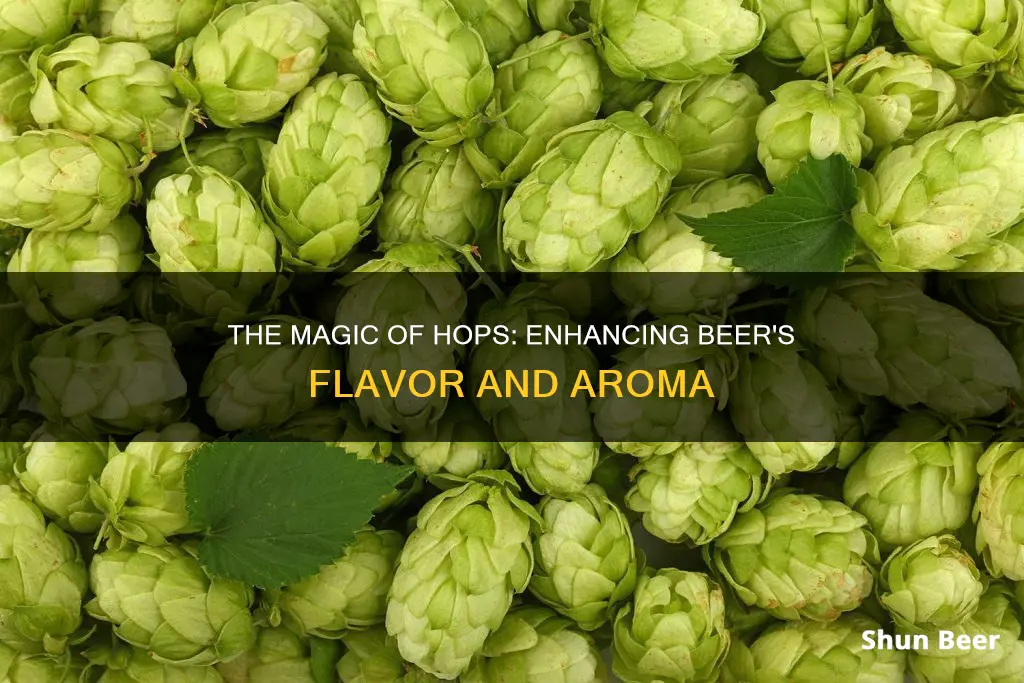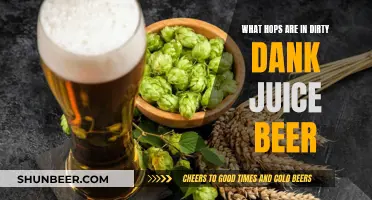
Hops are an essential ingredient in beer, alongside barley, yeast, and water. They are the flowers of the common hop plant, or Humulus lupulus, and are used primarily as a bittering, flavouring, and stabilising agent. Hops contain acids and oils that impart bitterness, flavour, and stability to the finished beer. They also have an antibacterial effect, suppressing the growth of undesirable microorganisms and acting as a preservative. The type and timing of hops added during the brewing process will vary depending on the style of beer being made. For example, hops added during the boil will bring out more bitterness, while hops added during fermentation, or dry hopping, will bring out specific flavours or aromas.
| Characteristics | Values |
|---|---|
| Purpose | Impart bitterness, flavour, and stability to the finished beer |
| Source | Hanging flowers of the Humulus lupulus plant |
| Flavour | Floral, fruity, or citrus |
| Aroma | Citrus, tropical fruit, piney, earthy, etc. |
| Type | Bittering, finishing, dual-use, or aroma |
| Preservation | Acts as a preservative due to its antibacterial properties |
What You'll Learn

Hops balance the sweetness of malt with bitterness
Hops are an essential ingredient in beer, adding bitterness, flavour, and stability to the final product. They are the flowers of the common hop plant, or Humulus lupulus, and contain resins and oils that contribute to the unique characteristics of beer.
One of the key roles of hops in beer is to balance the sweetness of malt with bitterness. This is achieved through the presence of alpha acids or humulones in hops, which are released during the boiling process and provide the bitter taste in beer. The longer the hops are boiled, the more alpha acids are released, resulting in increased bitterness. This process is crucial in creating a well-rounded flavour profile and preventing the beer from tasting overly sweet.
The addition of hops at different stages of the brewing process also affects the level of bitterness. Bittering hops are typically added early in the process and boiled for a longer duration to impart maximum bitterness. On the other hand, aroma hops are added towards the end of the boil or after fermentation to emphasise their aromatic qualities while minimising bitterness.
The type of hops used also plays a role in balancing sweetness and bitterness. Some hop varieties, known as bittering hops, have higher concentrations of alpha acids and are primarily used for their bittering properties. These hops are essential in counteracting the sweetness of the malt and creating a balanced flavour profile.
Additionally, the amount of hops added can be adjusted to control the level of bitterness. By varying the quantity of hops used, brewers can fine-tune the flavour and create a beer that is not overly sweet or bitter.
The interplay between the sweetness of malt and the bitterness of hops is a delicate balance that brewers strive to achieve. Through careful selection of hop varieties, timing of additions, and control of the boiling process, brewers can create beers with complex flavour profiles that appeal to a wide range of palates.
The Magic of Hop Extract in Beer Explained
You may want to see also

They add flavour and aroma to beer
Hops are the flowers of the hop plant Humulus lupulus. They are used to add flavour and aroma to beer. Hops contain resins and oils, found in the lupulin glands of the hop cones, that give beer its unique flavour and aroma. The types of hops used and the timing of their addition to the brewing process will determine the flavour and aroma of the beer.
The flavour and aroma of a beer depend on the types of hops used. There are 250 different varieties of hops, and each variety contributes different flavour and aroma notes to the beer. For example, Columbus hops add earthy and spicy notes, Mosaic hops offer notes of berry and stone fruit, and Tettnanger hops give off floral notes, earthiness, and a hint of citrus.
The timing of when hops are added to the brewing process also affects the flavour and aroma of the beer. Hops can be added during the boil stage, during fermentation (a technique known as dry hopping), or after fermentation. When hops are added during the boil, they can be added at different times to emphasise certain flavours or aromas. For example, if hops are added early in the process, they will release more alpha acids and impart more bitterness. If hops are added later in the process, their aromatics will be emphasised while imparting less bitterness.
Techniques such as dry hopping and wet hopping can also be used to add aroma and flavour to beer. Dry hopping involves fermenting beer with hops in it, which adds aroma without the extra bitterness. Wet hopping involves brewing with fresh, un-dried hops within 24 hours of being harvested, resulting in a vivid aroma and flavour profile with decreased bitterness.
By using different types of hops and adding them at different stages of the brewing process, brewers can create beers with a wide range of flavours and aromas.
Wheat Beer and Hops: An Unlikely Friendship
You may want to see also

Hops are added at different stages of the brewing process
The hops are added to the wort in three stages during the boil: bittering, flavour, and aroma. All beers have at least one hop addition for bitterness to balance the sweetness of the malt. However, the same hop variety can be used for bittering, flavouring, or aroma. The timing of the addition of hops is critical as it determines the characteristics that will be extracted from the hops. The longer the hops are exposed to heat, the more likely it is that bitterness will be achieved rather than flavour.
Bittering hops are added once the wort has been collected in the kettle and a rolling boil has been achieved. They are usually boiled for 60 minutes but can be boiled for as little as 30 minutes. The main reason for adding bittering hops is to balance out the sweetness of the beer. Additionally, hops are a natural preservative, helping the beer stay fresh for longer.
Flavouring hops are added with between 15 and 30 minutes remaining in the boil. During this time frame, very little bitterness will be extracted from the hops, but the crisp hoppy flavour will be imparted.
Aroma hops are added during the last 5 minutes of the boil or at flame out, when the kettle is removed from the heat. The hop oils responsible for the aroma are extremely volatile and will be driven off in the steam of the boil almost immediately, so aroma hops must not be boiled for long. Adding them at flame out will produce the maximum amount of aroma.
Hop Stoopid Beer's IBUs: A Strong Brew
You may want to see also

They act as a preservative, preventing spoilage
Hops are added to beer to act as a preservative, preventing spoilage. They have an antibacterial effect, suppressing the growth of undesirable microorganisms and allowing the brewer's yeast to grow. This antibacterial property is due to the antibiotic characteristics of the alpha acids or humulones in hops, which are thermally isomerized into iso-alpha acids or isohumulones during the wort boiling process. These iso-alpha acids are responsible for the bitter taste of beer.
The preservative effect of hops was historically significant, as beers made with hops were observed to have a longer shelf life and were less prone to spoilage compared to traditional herb-based combinations. This led to the gradual shift from using "gruit" (a mixture of bitter herbs and flowers) to hops for flavouring and bittering agents in beer.
Hops also contribute to the stability of the finished beer product. The acids in hops, particularly the iso-alpha acids, act as preservatives, ensuring the beer remains stable and preventing spoilage. This stability is crucial for maintaining the desired flavour and aroma profiles of the beer over time.
The addition of hops at different stages of the brewing process can also impact the preservative qualities of the final product. Bittering hops, added early in the process, provide the majority of the bitter flavour and act as a preservative. Aroma hops, on the other hand, are added later to emphasise their aromatic qualities and contribute less to bitterness and preservation.
The choice of hop variety and the timing of their addition to the brew are carefully considered by brewers to achieve the desired balance of flavour, aroma, and preservative effects in the final beer product.
Blue Moon Beer: Hops or No Hops?
You may want to see also

Hops have antibacterial properties
Hops have been used for centuries to keep away putrefactions from beverages. In today's language, this is equivalent to describing an antimicrobial effect. Hops have antibacterial properties, which means they can be used to fight against certain bacteria. This is especially true for gram-positive bacteria, which are inhibited by hops. The antibacterial activity of female inflorescences against Gram-positive bacteria have been well-documented.
The antibacterial activity of hops comes from the presence of bitter acids and prenylated phenolic compounds (phloroglucinol derivatives well known as bitter acids, chalcones, and flavanones). The main prenylated chalcone of hops, xanthohumol, and the leading compound of β-acids, lupulone, show very strong antibacterial activity. Hops also inhibit the replication and proliferation of some viruses, such as hepatitis C virus (HCV) and human immunodeficiency virus (HIV).
Hops have been traditionally applied for medicinal purposes, mainly for the treatment of sleeping disorders, activation of gastric functions, and as stomatic, antibacterial, and antifungal remedies. The antibacterial properties of hops make them excellent candidates for food preservation and natural pharmaceutical products.
The Hoppiest Beers: A Comprehensive Guide to Hoppy Brews
You may want to see also
Frequently asked questions
Hops are added to beer to impart bitterness, flavour, and stability. They add floral, fruity, or citrus flavours and aromas.
Hops are the cone-shaped flowers of the female hops plant, aka Humulus lupulus.
Hops are typically added to the wort in 3 stages during the boil: bittering, flavour, and aroma.







